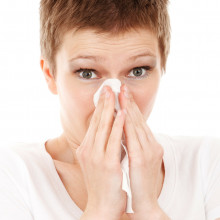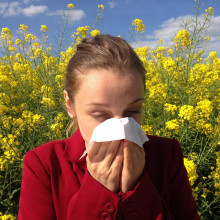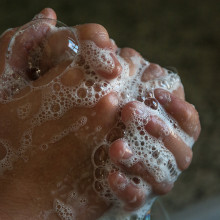Allergy Science: From Antibodies to Anaphylaxis
Hayfever causing you havoc? Is asthma proving to be an annoyance? This week, we’re talking allergies. What causes them, and can we reverse them? We talk to one specialist who’s making great strides in doing just that. Plus, in the news, a possible cure for the common cold, and are longer legs really more attractive?
In this episode

00:57 - A cure for the common cold?
A cure for the common cold?
with Professor Roberto Solari, Imperial College London
Each of us suffers about three “cold” virus infections every single year. They make us miserable, they spoil our holidays and they cost us time off work. And, sadly, there’s no cure - yet. But that might be about to change thanks to scientists at Imperial College who began by trying to develop drugs to fight malaria but accidentally along the way stumbled instead on a method to block the growth of rhinoviruses, which are the chief causes of colds. Their new agent temporarily deactivates an enzyme in human cells that these viruses use when they try to grow. Chris Smith spoke to Roberto Solari, who helped to invent it, asking Roberto firstly to explain what his group did...
Roberto - So we’ve been trying to find ways of nobbling or blocking the virus if you like. This is a very simple virus; it has a protein shell and it has genes inside that protein shell but, like all viruses, it can only make more copies of itself inside our own cells. So when the virus infects our cells, it hijacks our cellular machinery to make more copies of itself.
Back in the 80s it was known that related viruses, and that includes polio virus and foot and mouth virus, actually add a fat molecule onto their protein shell, and they use a host enzyme to add that fat molecule onto their protein shell. So we thought that making a drug that inhibited that enzyme might block the virus and that’s what effectively we’ve done.
Chris - Do you know why they add that fat molecule because the host factor that does that is called myristoyltransferase isn’t it?
Roberto - That’s right.
Chris - It’s an enzyme that basically takes the chuck of the virus coat that’s being built and add this extra molecule onto it, but why do the viruses do that?
Roberto - What we discovered is that if the virus can’t add the fat molecule, the coat protein doesn’t form properly. So the coat protein is made as a very large protein that gets clipped and the fat is required for that clipping of the coat protein, and if you can’t clip it, it actually doesn’t form a proper shell.
Chris - Hence, if you can come up with a way to, albeit temporarily, block that enzyme it should be possible to significantly disable the virus from its ability to grown inside a cell?
Roberto - And that’s exactly what we found. We take cells in culture, and we infect them with virus, and we add the drug, and then we measure growth of new viruses. And what we can see is when we infect human cells with the virus we can block that effect.
Chris - And to what extent is it blocked? As in, if you measure how much virus you would expect to come out, compared to how much does come out, what degree of knockdown do you get?
Roberto - I would say close to 100 percent. It’s very effective at inhibiting growth of the virus.
Chris - How do the cells that you treat with this compound fare? Do they tolerate it okay?
Roberto - For a couple of days they do. It is actually well tolerated and that’s going to be one of the key challenges going forward to take this from something that works in a laboratory to something that works in a clinic. We have to test the safety and toxicity of these molecules; that’s all going to happen in the pre-clinical development phase that we’re now entering.
Chris - I suppose with the viruses like rhinoviruses, which cause the common cold, they are really confined to the cells that line our nose and throat those infections aren’t they? So could you make an inhaled form that doesn’t affect the rest of the body and, therefore, you do have a prospect of minimising the side effects?
Roberto - That’s an excellent suggestion. So, there’s two things that will be in our favour. One is that the course of a viral infection tends to be rapid, it’s over in a couple of days. So this is not a drug that you would take for months, or years. And the other way of minimising any toxicity would be to deliver it to the nose, or the lungs, where the virus is, in fact, growing. So that we don’t have to expose the whole body to the drug. They would be the two ways we would seek to minimise any toxicity to the patient.

05:10 - What could 2 degrees C of warming do to life on Earth?
What could 2 degrees C of warming do to life on Earth?
with Professor Rachel Warren, University of East Anglia
Imagine being told that 50% of the area you live in is about to become uninhabitable? How would you react? Most probably with alarm. But the reality is that, according to a new study out this week, many species around the world, and possibly us too, are potentially facing this very problem, unless we take measures to curb climate change much more seriously. Izzie Clarke spoke to University of East Anglia climate scientist and author of the study Rachel Warren. They began by looking at what the Paris Agreement commits over 190 nations to achieve...
Rachel - The actual wording is to “reduce warming to well below 2 degrees, and to pursue efforts to limit the warming to 1½ degrees”. We wanted to see what the effect on biodiversity was of limiting global warming to 1½ rather than 2 degrees, because the previous studies had only looked at 2 degrees and above and there was very little work on 1½ degrees.
What we found was that the geographic ranges of species would fall greatly when the climate warms. We counted the proportion of species that we studied that would lose more than half their range. And we found that at 2 degrees,18 percent of insects, 16 percent of plants, and 8 percent of backboned animals would lose more than half their range. But, at 1.5 degrees C, that is reduced a lot to 6 percent of insects, 8 percent of plants, and 4 percent of vertebrates.
Izzie - So if we can reach that 1.5 degrees Celsius rather than 2, it’s a much better scenario for our wildlife and plants?
Rachel - That’s right, absolutely yes.
Izzie - Are we on track to even reach this?
Rachel - No we're not. And if temperatures were to rise by 3 degrees, actually our study estimates that 49 percent of the insects would lose more than half of their climatic range. Now that would have very far-reaching ecological consequences.
Izzie - Gosh. So 50 percent of insects would lose 50 percent of where they live, essentially?
Rachel - Right, exactly. The places where species are going to be happy living are going to move across the Earth’s surface. And when that happens, some of those spaces if you imagine it’s like a shadow. That shadow moves across a continent and it reaches a coastline and falls off, or it reaches the top of a mountain and disappears. So that’s one reason why we see these ranges shrinking. The other reason is because the species can’t move to keep up and, in particular, we are concerned about pollination. So the three groups of insects that are particularly important for pollination, which includes the bees of course, are amongst those that are at the highest risk.
Izzie - How many species were you looking at and how can you predict all of this in the first place?
Rachel - Okay. Well we looked at 31,000 species of insects.
Izzie - Gosh, that’s a lot.
Rachel - Yes, yes. And the reason we were able to do this is because there’s this wonderful organisation called the Global Biodiversity Information Facility, and that database allows us to associate the present day climate with the present day places where the species are found. Then we use a computer model to calculate how likely the species is to be there where that particularly preferred type of climate moves to geographically in the future.
Izzie - What are the implications of a study like this? What can we do now; what happens next?
Rachel - I think the key message is that if we want to avoid these kinds of consequences, countries would need to decide to do more to reduce their emissions so that we actually attain the objective of the Paris Agreement. Things that the average person can do is to get on your bike and cycle wherever possible rather than driving down to the local shop, and try to buy energy efficient appliances, recycle as much as possible. So, basically, just try to reduce your footprint and your energy consumption.

10:34 - Computers making phone calls
Computers making phone calls
with Peter Cowley, Angel investor
At a conference last week, a demo was played of a phone conversation between someone booking a hair salon appointment for a client, and a hair salon worker recieving the booking. So far so normal, only one of the women was not human. Chris Smith spoke to tech investor Peter Cowley to find out more...
Hello. How can I help you?
Hi. I’m calling to book a woman’s haircut for a client. Um, I’m looking for something on May 3rd.
Sure. Give me one second.
Mmh.
Sure, what time are you looking for around?
At 12.pm.
We do not have a 12pm available. The closest we have to that is a 1.15.
Do you have anything between 10am and, uh, 12pm?
Depending on what service she would like. What service is she looking for?
Just a woman’s haircut for now.
Chris - Peter, why are Google doing this?
Peter - We’ve heard of Google Assistant which is like Alexa and Siri, which is basically you ask a question and you get a reply. This is turning that further, this is called Google Duplex where Duplex in this situation means bidirectional, so it’s generating dialogue. And the reason they started this, apparently, is because 60 percent of all businesses in the US don’t take online bookings, and they only take it by voice. So, therefore, they’ve demonstrated this to show that it can be done (A) interactively, and (B) with these umms and errs so it sounds like a human being.
I demonstrated this to a group last night at a dinner party and they were absolutely astonished, and there were several people got it wrong, which one was.
Chris - Yes, which one was real, yeah. Why on earth were you doing that a dinner party? Didn’t you have anything decent to talk about?
Peter - Because I was coming to see you today, Chris.
Chris - But, how on earth are they doing this?
Peter - Well, recognition has been around for 20 or 30 years and it’s getting better and better. And many of our listeners will have some sort of device in the home - which is recognising what you’re saying; most of the time it’s getting it correctly.
We’ve had speech synthesis around for years and years and years. This is coupling together. But the important thing it’s putting a level of machine learning or artificial intelligence if you want, which will actually interpret what’s being said by the human and then play something back with a synthesis.
Chris - What’s the processing overhead behind this? Is this an enormous supercomputer required to do this? Or is this potentially scalable, as in do you need a small device to do this so that you could have people having conversations with computers that are meaningful without having to really use the entire Google network to do it?
Peter - A great question. It will end up in our phones at some point. Basically, machine learning requires what’s called a neural net, and a neural nets generally are, fairly slow and very pressure intensive when they’re done in software, but they will end up in hardware. So at the moment yes, it does use the massive set of servers, but in time it will be possible to do it on a much smaller device.
Chris - Now, down to the point of actually why they are doing this, what’s their perceived need? Why do they think that people are going to buy into this and why do they think people this kind of umm and err and pretending to be human? Because, actually that’s a bit deceitful. That makes me uneasy.
Peter - Yeah. Let’s answer the second part first. Communication is more natural if you get the umms and errs and hesitations etc. So then it becomes much more acceptable that it is bidirectional with a human being and, actually, the end result will be better. The human that’s receiving it, in that case the hair salon, is unlikely to recognise that it wasn’t a human at the other end. It hasn’t got impatient or anything or hasn’t tried it out so it will actually speed up that sort of communication. It also, for Google, is doing a demonstration of where the technology is going because it will become bidirectional, Duplex will become a dialogue.
Chris - There was a gentleman we had on this programme a few years back who actually showed that people tend to put in errs and umms ahead of an item in a sentence that they were seeking to emphasise. And he noticed this particularly in parents teaching children language because if you say oh, look at the umm plane in the sky. Actually what it does is it creates a bit of cognitive space, but it also cues the individual oh look, potentially new word or important word coming, you must attend to this. So is Google adding the errs and umms in the right place and does it have the capacity to learn to do that?
Peter - Again, another great question. I think it comes back down to it’s this communication that perfect communication without the umms and errs sounds stultified. I mean, you run podcasts, I run podcasts, we actually take our umms and errs out. I don’t know if you do, after you’ve put this on the Naked Scientists?
Chris - We don’t sterilize the conversation completely for the simple reason that it doesn’t sound like natural speech if you do that. And for the reason that I learned from reading this gentleman’s paper in Science that actually I might be, by sterilizing the errs and umms, I might actually be taking the emphasis away from key components of the sentence, so we want it to sound natural. And of course, all our guests here on the programme are so good at speaking that they don’t say err and umm very much anyway.
Peter - Not me, umm.
Chris - No, not very much. But is there not a risk though that umm people might be deceived by a system like this, or feel deceived?
Peter - Yes, I don’t know if you noticed, in the press last week there was a guy that was doing robocalls in the States; these are robotic calls. And these are simple ones and he was fined almost 90 million pounds for doing this, for spamming people, effectively. But, if you took it further on, you have got this ethical issue that you could confuse. Even solicitors are being conned effectively with the right communication to hand over large sums of money.
Chris - So in future we might see these sorts of calls opening with: by the way, you’re talking to a non-human assistant?
Peter - Google have already said that. They’ve already said that even between last week and this week they’re going to. In some states in the States and other parts of the world they’ve have to say because it’s a recording. And secondly they’re going to introduce :this is Google Assistant or something.

16:42 - Down to Earth: optical measurement technique
Down to Earth: optical measurement technique
with Dr Stuart Higgins, Imperial College London
How has the space race has brought us better contact lenses and made cataract surgery safer? Here's Stuart Higgins to tell us...
Stuart - Welcome to Down to Earth from the Naked Scientists. The mini series that explores the spinoffs from space technology that are being used on Earth. I’m Dr Stuart Higgins.
This episode: how a method used to measure how liquids and gases behave in zero G is being used to check the safety of contact lenses back on Earth.
The flow of a liquid or gas through a pipe might seem simple but, in reality, it’s extremely complicated, in particular when there’s a mixture of both liquid and gas at the same time. Such mixtures are often found in the cooling system used on board spacecraft and, as spacecraft get bigger, scientists and engineers want to understand better how these mixtures behave when they’re not experiencing gravity.
One company working with the European Space Agency (ESA) helped build the tools to measure the behaviour of liquids and gases in an experiment on board the International Space Station. Their system can measure the complex flow of liquids simply by looking at how a light passes through them. It’s based around Schlieren imaging, a technique dating back to the 1800s.
Light passing through a fluid at an angle will change direction, and the amount it shifts is determined by the material’s refractive index. Water has a higher refractive index than air, which is why things look distorted when you look through a glass of it. However, the refractive index can change with the density of fluid too.
Schlieren imaging passes light through a fluid and then focuses it onto a knife edge or a grid, blocking out about half the light. Behind this block sits a camera. Changes in the refractive index of a fluid, say from a shockwave, will cause some of the light to bend more strongly hitting the block and showing up as a dark shadow in the camera. The camera sees a shimmering pattern of moving fluid which represents areas of different density allowing its behaviour to be studied.
The company working with ESA invented a new variation of the Schlieren technique called Phase Shifting Schlieren, which also looks at how the phase of light changes as it passes through the fluid allowing them to measure with even greater precision. And this seemingly niche piece of technology found an unexpected application in helping to create better and safer contact lenses.
It began one day when an engineer tried placing their glasses inside one of the measuring systems to see what would happen. They found that their Phase Shifting Schlieren technique allowed them to map both the surface and inside of lenses with much greater precision than existing methods. The company built a new tool around the technique that can be used to inspect contact lenses, and also the artificial lenses used by surgeons in cataract patients helping to ensure there are no defects before the lense is surgically implanted.
So that’s how measuring complex fluid flows in space can be used to improve the quality of contact lenses and cataract implants back on Earth.

19:55 - Are longer legs really more attractive?
Are longer legs really more attractive?
with Tom Versluys - Cambridge University
How long are your legs? Because a paper out this week has shown that women like their men a little bit on the lanky side, after researchers asked women to rate hundreds of photos of men with adjusted arm and leg lengths. Katie Haylor spoke to researcher Tom Versluys, who did this work whilst at Cambridge University...
Tom - We looked at the relationship between limb proportions and attractiveness in men as judged by females. We took computer generated human models of men, we manipulated their limb proportions based on the natural variation in a database of American military personnel, and we had them rated for attractiveness by a sample of online women.
Katie - Okay. So what did you find then?
Tom - We found that legs - I should emphasise first that it’s relative limb proportions so we held height constant for all our models. We found that relative leg length was slightly more appealing when it was just above the average. And that arm length had no effect on attractiveness it seemed. And that the intralimb ratio, so the ratio of the lower limb segment to the upper was preferred when it was average.
Chris - Can I just clarify; is this women rating men and these women are straight women?
Tom - Yes.
Chris - So what happens if you ask men who are gay men to rate men’s leg lengths? Does the same thing hold?
Tom - Well, we didn’t explore that. Homosexual attraction and mate preference in general is very poorly understood; that’s a huge gap in the literature which will be explored in the coming years.
Katie - So, is it fair to say women do find male longer legs more attractive?
Tom - Yes. Our results were quite robust in that respect - only slightly.
Katie - But why is this the case?
Tom - Well, there are a few reasons why it might be the case. For one it’s important to note that there’s preference only for slightly longer legs, and so we’d expect preferences to orientate around the average because that’s supposed to indicate genetic diversity and, therefore, strong immune systems, so resistance to disease.
Katie - Oh okay. So you mean it might be a better potential mate potentially?
Tom, Yeah, exactly. It’s all based around mate value so you’d expect something close to the average. But the reason that there’s a preference for slightly longer legs is probably because during development this indicates developmental stability, good nutrition. It also, arguably, indicates biomechanical efficiency which would have been good in ancestral populations for walking, running, etc.
Katie - Okay. By biomechanical efficiency you mean being fitter?
Tom - Biomechanical efficiency basically means it costs less energy to move around.
Katie - Ah okay. Hang on, what about really long legs?
Tom - Really long legs are almost universally unappealing it would appear because they are often associated with harmful genetic conditions.
Chris - What about if you were a daddy long legs?
Tom - Well, I don’t know. We’d have to -
Katie - Excluded from the study!
Tom - Suddenly this is a different kind of study.
Chris - What I was getting at is do animals do this?
Tom - There'll be a similar kind of process. In fact it’ll probably be more acute in a certain sense because it won’t interact with social factors and socialisation. Animals will make attractiveness judgements based on mate value of the individual in question.
Katie - Now, I think studies like this have been done before, am I right?
Tom - Yeah, they have yeah.
Katie - So what makes your one, this new one different?
Tom - Well, although the previous literature is valuable, it had several problems. They were generally to do with the methods that were used. In particular the stimuli, which are the male models or the female models, whichever sex one was looking at, they tended to be non anatomical. So they were made in a fairly arbitrary way without reference to a reliable database, their limb proportions were manipulated often in an arbitrary manner and sometimes to the point where the fell outside the natural distribution, which means they could be testing people who you might never see in real life.
Katie - And very quickly; why do you think that legs but not arms had an effect?
Tom - This is a difficult one. We hypothesised that both would have an effect, so we can make some conjectures. So arms are less variable during development in response to harmful forces such as malnutrition, so you would think that legs would be a stronger signal so there’d be a stronger evolutionary pressure for that to happen. Legs: also the biomechanical efficiency in terms of walking and running efficiency, legs would be a more important signal. Arms don’t signal that.

25:58 - What are allergies?
What are allergies?
with Dr Eoin McKinney, Cambridge University
To unpack what an allergy actually is, and what’s going on in the body when someone has an allergic reaction, Chris Smith spoke to Eoin McKinney - an immunologist at Cambridge University. First of all Chris asked Eoin to explain exactly what an allergy is...
Eoin - Good question. There’s two key points to the answer: the first is what you would notice if you had one yourself and the second is what’s going on inside your body to cause it. It’s probably easier to start with the second one first.
It boils down to your immune system. And the point of your immune system is to repel invaders. To stop bugs, bacteria, viruses getting in and causing disease. And for bacterial and viruses that are extremely small, your immune system has cells that can effectively gobble up those pathogens and wave them around so that the rest of your immune system attacks them.
But sometimes there are pathogens that are too large and that can’t really happen to, so there’s a separate branch of your immune system that deals with that. The sorts of things we're talking about here are parasites or worms. There are a branch of cells, including specialised cells called mast cells stuffed full of granules and toxic proteins that they can release to repel or kill the invading worm or parasite.
Chris - And where are these mast cells?
Eoin - Throughout your body but they’re the sort of places you might expect if you were to plan a defence. So they’re lining your nose, they’re lining your lungs, they’re lining your gut, and they patrol around looking for trouble and trying to sort it out. When they see it, they release the proteins, repel or kill the invading bug and that should be that.
Chris - Right. So say some kind of parasite is trying to get through my skin it would engage with one of these cells - these mast cells - trigger it, a bit like a tripwire and it would then discharge things like histamine out of the skin and that would be why I would develop a local reaction like in the case we were saying hay fever, so that’s a pollen is hitting the skin, eyes, nose and throat and it’s causing the histamine to be released?
Eoin - It is indeed, you're absolutely right. In the case of a worm, you’d have all these things released and you would still notice inflammation. So it might hurt, it might go red and that’s partly due to these toxic chemicals being released but it’s doing you good.
Chris - But why is it doing me good? It doesn’t feel like it’s doing me good is what I’m getting at, so why is that beneficial?
Eoin - It would be beneficial if it was targeting a worm or a parasite. If it’s targeting something that’s a natural component of your environment, like grass pollen, like peanut, like egg. We could go on for the huge list of things, that’s not beneficial and you really don’t want that to take place; that’s an accident and that’s why it’s a disease.
Chris - Why is it that it’s confined in hay fever just to my eyes and nose? But if I’m allergic, we heard just now about a young person with a nut allergy you can get symptoms all over your body, so why is there that difference?
Eoin - It partly comes down to the severity of the response. An allergy is not like a binary on or off phenomenon, you can have it but it can be low grade. Or you can have it and it can be extremely severe and there’s a continuum the whole way along. The low grade stuff you get local reactions where the pollen coming in. It’s coming into your eyes, your nose and you have a local reaction there. If you have a much more severe reaction, such as to peanuts, it can affect the whole of your body. Not just small blood vessels dilate to give you a rash, they all do that. Your blood pressure can drop to your boots and it can actually be extremely dangerous or life-threatening.
Chris - Now you’re not born with an allergy, are you? Because your immune system is immature when you’re born and it has to learn from the environment what is good and what is bad. So how do allergies get started in the first place, do we know?
Eoin - The short answer is not really. You’re not born with an allergy but you can be born with a propensity to develop it.
Chris - So it can run in a family effectively and have a tendency towards an allergy?
Eoin - A tendency towards it can run in a family. It’s a risk so it’s not like there is a gene for allergy that you will inherit but you can be born with an increased risk for allergy. Now that’s great if that increased chance of an allergic type response helps you repel parasites and worms, but it’s not so good if it makes you react more against things you shouldn’t like grass pollen. So in some spectrums an allergic response can be helpful but in others not. It depends on the circumstance.
Chris - And in terms of managing allergy, obviously not being exposed to the thing you know triggers these symptoms is one way to manage it but that’s not always possible is it? If you’ve got to go about your day to day business and you’re reacting to pollen which is so tiny it’s just in the air all around you. So what’s the best way that a person can manage an allergic condition?
Eoin - Our treatment so far have largely been limited to trying to turn off these toxic chemicals like you mentioned histamines. And the cells are releasing histamine as a way of trying to agitate and get rid of the worm or parasite for example or, in this case, attacking the pollen, and we have things that can block that. So antihistamines are the drugs we take that simply try to stop the affective proteins that are driving the response.
Chris - So you pop a pill; that antihistamine drug goes round your system. How does it then stop, or how does it now where the allergic reaction going to happen so it knows to block it there?
Eoin - It doesn’t is the short answer. There’s no specific targeting of an antihistamine. It gets absorbed into your system, you’ve got it throughout your entire body and that’s why some of them have side effects that cause a bit of drowsiness as well because the affect other things too. It’s not as targeted or selective as we would like.
Chris - In essence, you're damping down your immune system a bit all round your body and that way you’re blocking the effect were it to happen in that particular area because the antihistamine is already there? So you’ve got to take it before you’re exposed, basically?
Eoin - No, not at all. In fact, as you know, everyone takes antihistamines after they’ve been exposed. The histamine is the protein that’s been released so it can still work when you take it after the response has started. In some instances, people take it beforehand to stop it starting or to limit it’s onset as well, but it’s never 100 percent effective.
Chris - And just very briefly, apart from antihistamines, any other drugs or classes of drugs that can be used to control allergies?
Eoin - Yes. There’s a class of drug called steroids. Now not the sort of steroids you might have associated with the Olympics, but the sort of steroid that can dampen down your immune response. They’re widely used for a huge range of different sorts of immune diseases because they dampen down the immune response a little bit, or a lot depending on the dose. Your immune systems a bit like a thermostat and what you want to do is turn it down a couple of degrees, not turn the heating off.

32:11 - How much of a problem are allergies?
How much of a problem are allergies?
with Professor Sheena Cruickshank, University of Manchester
What’s the scale of the problem when it comes to allergies? Katie Haylor spoke to Sheena Cruickshank from the University of Manchester. First of all Katie asked Sheena how prevalence of allergy varies across the world...
Sheena - In the UK we have about one in four of us having hay fever allergies, so they’re pretty common. But worldwide we see a real variation, about ten to 40 percent of the population across the world will have an allergy. And what we tend to see is that it varies depending on whether you live in a more developed part of the world or less developed part of the world. So the more developed the area the more likely you are to have an allergy.
Katie - And why is that, do we know?
Sheena - Well, we don’t fully know but there’s an awful lot of ideas as to why that might occur, but one of the ideas is that it’s about the differences in the environment. It’s the microbes that we’re exposed to, it’s the pollutants that we’re exposed to, and it’s the different germs and things that perhaps live inside us; things like our gut bacteria will be different.
Katie - From a population health perspective, how has this incidence of allergy changed over time?
Sheena - It’s changed massively. We see a real increase; for example we’ve seen a 615 percent increase in anaphylaxis, which is a very severe form of allergy in the 20 years running up to 2012. And year on year we’re seeing more diagnosis and more hospitalisations in the UK, so it’s a really steep increase. There’s evidence to suggest that if it keeps going up like this, by 2025 half the population of the UK will have an allergy.
Katie - Why has this increased so much?
Sheena - You can be a little bit genetically susceptible, but what they know now is that genetics isn’t the only thing and the environment, in some way, seems to be really really important, so it’s something that we’re exposed to in our environment. It could be microbes that we’re breathing in - different types. It could be different pollutants. It could be all sorts of things that are sort of coming together and making our immune system respond in a way that it shouldn’t because what an allergy is is essentially your immune response reacting to something that is harmless that you should ignore.
Katie - Now you’re getting the public involved in allergy research as I understand. Tell us about that.
Sheena - We’re really excited about this. We’ve worked with people with allergies and asthma to co-create an app to gather symptom data across the UK. And what that does is we get different symptoms, and we get a timestamp, and a geolocation. So, for the first time ever, we’re able to see when allergy symptoms start to develop and where you were when that happened.
Katie - And rumour has it that you do have some preliminary findings?
Sheena - Yes, that’s right. We have some preliminary evidence where we’ve been looking at possible linkage between the symptoms and different pollutants because we’ve got very detailed data from Manchester. What we’re seeing is correlation between these symptoms and pollutants, in particular things like NOx which we associate with diesel fuel and also some of the larger airborne particles.
Chris - Sheena why do you think that having a bad air day is associated with certain allergic symptoms? Is it doing something to the mucus membranes: eyes, throat, lungs and so on and those mast cells that Eoin was telling us about?
Sheena - Well, there’s a few ideas that it could be. One thing is that it could be damaging our mucus linings, and then that acts as an extra trigger to alert the immune response and kind of fires the immune response off. Another idea is that actually what it does is it changes the structure of the things that we’re allergic to, so it makes them even more stimulating to our immune response, so there’s quite a few different ideas there. But certainly we do see evidence that if there’s heavy pollution we see a lot more hospitalisations for things like asthma attacks and for other people who’ve got breathing associated difficulties. Diseases like COPD for example we will often see that they will feel a lot worse.

36:30 - Is being too clean responsible for the rise in allergies?
Is being too clean responsible for the rise in allergies?
with Professor Sheena Cruickshank, University of Manchester
It’s often claimed that we’re living “too clean a life” these days, and this is one reason why allergy rates have risen. Chris Smith put this to Sheena Cruickshank from the University of Manchester...
Sheena - What you’re describing there is something call the Hygiene Hypothesis which was developed a few years ago by a scientist called David Strachan. And what he observed was that people who lived in the country and had very big family groups were much less likely to have allergies than people who lived say in the city and had quite small families. His idea was perhaps the difference between the sort of large family group and the country was that you go a lot more exposure to a whole variety of different germs at an early age, which then trained your immune response up so that it was much less likely to misfire. But this hypothesis has very slightly gone out of favour now. We have a new version called the Old Friends hypothesis. Do you want me to tell you about that?
Chris - Go on then tell me about some of my old friends.
Sheena - Your old friends. Well, this is taking the idea that, obviously, we’ve got all sorts of things that live inside us and on us. We have the bacteria and the viruses etc., that make up our microbiome that are very very important for our health. And these develop in response to things that we eat, things that we’re exposed to in the environment - all sorts of things, and perhaps they are one of the factors that could be really important in helping develop our immune response. Then there’s the other idea as well that we don’t get the same types of infections that we used to. If you go back to the time of King Richard III, we know that we all used to have a lot of parasitic worm infections which is what Eoin was talking about, and our immune response therefore evolved alongside these worm infections. We don’t have these now, so is it the combination of lacking our old friends - things like the worms, or having very different types of bacteria that we breathe in or live in and on us that means that our immune response doesn’t get the right signals to develop and then goes wonky?
Chris - There’s also evidence that the microbes that live in our mum’s gut when we’re developing inside our mum have a chemical conversation with the developing baby in terms of patterning how the blood/brain barrier that separates the brain tissue from the bloodstream develops. So do you think there’s also a possibility that what mothers eat when they’re pregnant could affect the susceptibility of their offspring to being allergic?
Sheena - It’s possible. I think there’s evidence for and against that. There were some studies that were sort of suggesting that you shouldn’t eat peanuts, for example, when you’re pregnant because it would be bad for the baby, and then a lot of the allergies actually went up. So I think we don’t know, but it’s very very clear that the bacteria that we have are very important for the development and education of our immune system and if you’re born in a very sterile environment - so if you take a mouse that never has any bacteria - it’s immune system doesn’t develop as well as one that is exposed to bacteria. And, certainly, we do get exposure through the maternal interface with their bacteria and also we get education from the immune system, so there might be something in that. I think there’s a lot more that we need to find out.
Chris - So Sheena, does this mean then that perhaps we should be encouraging people in the modern era to embrace the microbial world more, go and roll around in dirt and muck and allow our kids to go and get more filthy than we do or actually, probably is that not such a good idea?
Sheena - Well, I think the most important thing to realise is that until we had the sort of hygienic conditions that we do and particular changes in sanitation, our average lifespan was around the age of 40 and so, basically, being cleaner has made us able to live a lot longer. So I think, overall, being clean is better than not being clean and having less infections is better for you.

40:53 - Peanut allergies - can they be reversed?
Peanut allergies - can they be reversed?
with Dr Pamela Ewan, Cambridge Peanut Allergy Clinic
Allergies can vary widely in severity. While some are undoubtedly inconvenient, others can actually be life threatening. Chris Smith spoke to Pamela Ewan from the Cambridge Peanut Allergy Clinic. But first, Katie Haylor heard about what it's like to have a peanut allergy. She spoke to Maaike and her son, Dillon...
Maaike - When Dillon was about 18 months old he was in the garden with his dad and his brother filling up bird feeders with peanuts. And his arm was in a sack of peanuts and he came back into the house and rubbed his eyes and had an immediate reaction which resulted in us ultimately being diagnosed with peanut allergy.
Katie - How does it affect your day-to-day?
Maaike - It becomes the most important thing in your life because you need to keep them safe. We’ve been unable to be spontaneous. It makes your world very small to begin with but, luckily, we have the resources and the kind friends and family to make it possible to do lots of normal things.
Katie - It sounds like it’s something that takes a lot of planning, a lot of effort and is quite stressful?
Maaike - Yeah, I think that’s accurate. It’s huge in its detrimental effect on family life.
Katie - Dillion, what’s it like having a peanut allergy?
Dillon - Well, it’s a bit hard because we have to check the labels of most things. And, at like a birthday party, they have a cake with peanuts and I have to just deal with it and not have it.
Chris - And we’ll hear a bit more from Dillon and Maaike, later in the programme. But first we’re joined by Pamela Ewan. She is a consultant allergy specialist at the Cambridge Peanut Allergy Clinic and she treats people just like Dillon.
Chris - Why are those allergies so severe Pam?
Pam - Well, no-one really knows why peanut allergy is so severe, but of the foods it’s the one that is the worst so it’s the most common of the foods to cause very severe, sometimes fatal reactions. So it’s a very bad one.
Chris - What age would a parent first notice that their child is like Dillon? What age does it tend to kick in at?
Pam - The average age is around two for the first symptom in a child but it could occur at any age and, obviously, that depends a bit on exposure. If you don’t start eating peanuts until you’re older, which is what happens now, probably that age of two is going to go up quite a lot.
Chris - And Pam, is there an age at which you grow out of allergies? Or can you grow into them paradoxically as you get older because this is something I’ve often wondered because I think I have less bad hay fever in my adulthood than I did in my childhood, or is that just because I’m better at avoiding the problem?
Pam - Mostly people develop an allergy either in childhood or early adult life but we see a few people, even into their 70s getting their first allergy. On the whole, most adults have got allergy don’t actually get better, but certainly some do and particularly described for hay fever waning as they get a bit older. We don’t really fully understand this but I think it’s a balance between the drive to allergic antibody versus those forces we talked about earlier which are trying to switch that off or downregulate it.
Chris - Something that Sheena said was mothers not eating peanuts when they were pregnant. There was some countries where this was put out as advice, wasn’t it, and then they did see an apparent increase in peanut allergy afterwards? Where do you stand on that?
Pam - That advice as actually not scientifically based. So it was thought to be a good idea but there was no solid evidence to support it. There is a study now which tried a very early introduction of peanut into babies and they did manage to lower the incidence of peanut allergy. But a problem they encountered in that study was that when they tested quite small children they found they already had a peanut allergic antibody, the bad antibody, so it’s not that simple to do. So it would be risky for mothers to start feeding their children peanuts without actually knowing did they have that allergic antibody on board or not, so it’s not something people should just try randomly.
Chris - In the population at large, a person picked at random, how likely are they to have a very profound peanut allergy and are you seeing that number climbing, staying the same, decreasing?
Pam - Well, 2 percent of children have a peanut allergy so that means one in every fifty. You could say almost nearly one in every primary school class.
Chris - And has that changed?
Pam - It was very rare to have a peanut allergy until the 1990s. We hardly ever saw a case and there was a big increase in the 90s. It’s gone up, yes, it’s gone up three or four more times since then. We haven’t actually got the latest data so we feel it’s probably leveling off but, without hard data to show that.
Chris - When a person has a very profound reaction what’s actually happening to their body so that they have that collapse and anaphylaxis?
Pam. They’re having this very widespread histamine release which cause a whole range of different symptoms. But particularly in these severe reactions with peanuts the main problem is very bad breathing, so they either get really severe asthma. Even more often closing up of the lining of the throat so they are basically being asphyxiated.
Chirs - How do you investigate them?
Pam - What is very important is do do what we doctors call’ take a history.’ That means we go into the details of exactly what happened, timing in relation to food, did they know what they’d actually eaten, did they know what the symptoms were. So we form a picture in that way then we back it up with tests.
Chris - When you say that what would you do? You’d expose someone to a bit of peanut?
Pam - We just put a little bit of peanut solution (an extract of peanut) onto the skin and prick it into the skin. It’s not like a blood test, it’s a very minor thing to do. And what happens is you get this reaction that Eoin was describing earlier, histamine release and you get swelling and redness and itching, so you get a think that looks a bit like a nettle sting.
Chris - And that tells you this person is reacting, so you know they’ve got an underlying allergy? How do you then manage them?
Pam - The current management is avoiding the food, so avoiding peanut. Now that’s tricky because peanut is hugely widely used in the food industry so it’s in loads of things. Not just the things you might expect but it’s added to unusual things so it’s very hard to do that. That’s the mainstay of treatment combined with carrying the medicines to treat reactions, and the particular one for the very severe reactions is an adrenaline pen.
Chris - So one would administer that the minute you think you’ve been exposed or that you begin to get symptoms?
Pam - When you get symptoms yes, because you can have a range of severity. It’s not everybody who’s going to have devastating reactions. So these patients will carry antihistamines and the adrenaline pen if needs be.
Chris - The treatment that you’ve been investigating is rather than treat the symptoms and rescue people, you’re trying to stop it happening at all?
Pam - Yes. We’ve been trying something called desensitisation. What that involves is trying to reprogramme the immune response, switch off the harmful allergic response and instead induce a beneficial response. It’s not usually possible to do it totally but you can certainly downregulate the bad response and upregulate, increase the good response.
Chris - How do you do it?
Pam - I should say this is very new for a food. So immunotherapy or desensitisation has been around for a hundred years but it hasn’t been tried for foods until very recently. We start with very small amounts of peanut and it’s given by mouth, taken every day. And every two weeks the patient comes back to our clinic, we increase the amount they’re given and then they take that same dose at home, so every time they have a bigger dose they’re in a safe environment with doctors and nurses. It takes 14 weeks to go from a very tiny dose up to taking between 1½ and 2 peanuts equivalent. It’s not given as peanuts but it’s given as a measured protein, peanut protein.
Chris - We’ll hear how Dillon got on…
Katie - Maaike, you’ve got what looks like a chocolate mousse pot…
Maaike - And we open the capsule carefully over the mousse and we put it in. There’s quite a lot of peanut flour in there. Then I check to make sure it’s empty and then we mix it in. Good job. Good boy.
Katie - So now you’ve done that bit it’s time for sweets.
Maaike - It’s given us the freedom to engage in usual family life, and go on holidays, and see friends, and be excited about an ice cream van instead of dreading the sight of one. And it’s also given us increased safety and I mean that’s a fundamental change I think in the event that Dillon is accidently exposed to peanuts somehow, he will will be able to tolerate that much better than he could before.
Chris - So you heard there they’re sprinkling little bits of peanut extract onto something he likes eating to make sure he continuously presents the particular thing he’s allergic to. But why does that work Pam? Why does that downregulate the profound response he was having before?
Pam - Basically, it is changing the regulatory cells that are in the system which control the production of theis allergic or harmful antibody so it’s trying to reduce the production of that. And we can show that by monitoring these patients with these tests that the allergic antibody gradually declines.
Chris - What stage are you at with this though? Because we heard from Dillon, he’s one of your patients. Is this something that people can routinely come and seek out from you clinic yet?
Pam - No. Well, we’ve done a lot of research, which has been published, which clearly shows the treatment is effective. What we’re doing now is offering a sort of early access to treatment. We haven’t got a licensed medicine and we’re working on further research which will actually take a while. It’s quite complex getting a drug licence but we’re well…
Chris - What for peanuts?
Pam - Though it starts as a foodstuff, we have to do it exactly as stringently as you would if you were making a drug out of a molecule. So we have to go through the whole regulatory system which is massive. So we’re well on the way to that and we’re coming up to what is called the phase 3 trial which is the last step in the pathway. We’re doing that but, in the meantime, we’re offering this early access to treatment. We’re doing it in the Cambridge Peanut Allergy Clinic where we offer this treatment as part of a range of services we offer. Unfortunately, we’re only able to do this privately because the NHS have not yet commissioned this and are unlikely to do so until we’ve got a full license. So it’s restricted, but it’s probably better than nothing.
Chris - And just very briefly, does this work on everybody?
Pam - It works on most people. We have currently in our clinic we’re having success in high 90s - 95 percent plus patients we can achieve this, so pretty impressive.

51:44 - QotW - Why does my nose run when it's cold?
QotW - Why does my nose run when it's cold?
Izzie - We turned to the Naked Scientist forum to dig out an answer...
One user thought it might have something to do with diet, saying: dairy can cause more mucus; try consuming less and see if that helps. But that might be a myth.
Another forum member, Alan, aptly quoted Chaucer - perhaps a first for the Naked Scientists. “If your nose runs in cold weather, and your feet smell in hot weather you’re upside down.”
We decided to take this ‘snotty’ situation to Ear, Nose and Throat specialist, Neil Donnelly from Addenbrooke’s Hospital…
Neil - This common condition our cyclist is describing is known as ‘skier’s nose’ or ‘cold induced rhinorrhea.’ Rhinorrhea is the medical term for a runny nose and you may be more likely to suffer from this if you have hay fever or asthma.
The nose is like an air conditioning unit for the lungs. This involves heating and humidifying the air that we breathe as well as filtering out any impurities.
Izzie - There are two reasons for experiencing a runny nose when the air is cold and dry…
Neil - This cold dry air requires a greater amount of heating and humidification to protect the lungs. The blood vessels in the nose expand to increase the surface area for heating which is why our noses feel blocked and the mucus glands lining the nose produce more runny mucus for humidification; hence that snotty drip.
The second factor is that the air that we exhale is warm and moist. When this saturated humid air hits the cold temperatures towards the nostril, water condenses and drips out of the nose. The effect is like steam condensing on a cold bathroom window.
Izzie - So what can be done to prevent this nasal niggling short of becoming a dry nose couch potato or relocating with Mark Cavendish to somewhere warm for winter training?
Neil - Simple measures include carrying industrial quantities of tissues or protecting the nose with a scarf or buff. The latter not only results in less running but also collects any unwanted drips. Afterall, the nose is capable of producing a pint of snot per day.
Certain types of medication may also be beneficial if the rhinorrhea is particularly troublesome. These include nasal decongestants that limit the blood vessels’ dilation and other medicines that reduce the amount of mucus that’s trying to escape from your nose. It is important to point out however that their use should only ever be for short periods of time as long term use can result in unwanted side effects.
Izzie - Thanks Neil for sniffing out an answer. Next time we dig into this question from Eamon:
If someday we manage to travel to another planet and discovered aliens, what is the likelihood that we could eat them?










Comments
Add a comment